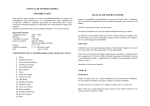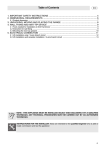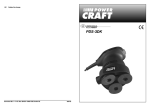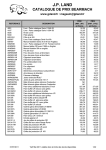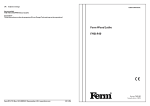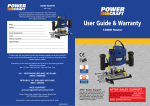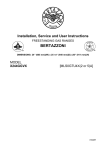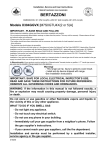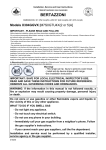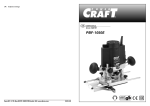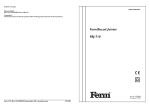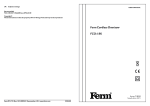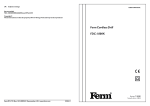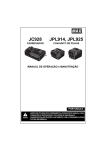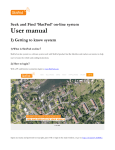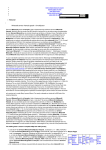Download 820110 Manual-UK # 0304-17
Transcript
UK Subject to change UK USERS MANUAL Art.nr. 820110 PBS-205/1000 0304-17 1 2 EXPLODED VIEW 3 15 14 4 5 6 13 7 12 11 8 10 9 Fig. 4 - Adjusting angle of bottom plate Fig. 1 - Description Fig. 2 - Changing the saw blades Fig. 3 - Assembling saw 2 Fig. 5 - Sawing a work piece Fig. 6 - Positioning parallel saw guide Powercraft Powercraft 11 SAFETY INSTRUCTIONS SPARE PARTS FERM. NR. DESCRIPTION 407680 RULER 001 407557 SQUARE NUT 002 407455 KNOB 003 407555 MOVABLE QUARD 407681 SUNK SCREW M3 X 12 009 407560 TABLE INSERT 010 407558 RIVING KNIFE 014 - 018 407682 HANDLE LOCK SCREW 022 407683 NUT M12 023 407553 FIXING GUARD 024 407552 OUTER FLANGE 027 407551 INNER FLANGE 030 407684 STAND BAR 034 407559 SWITCH 036 407763 MOTOR 1000 WATT 038 The following symbols are used in these instructions for use: REF. NR. SAW BENCH THE NUMBERS IN THE FOLLOWING TEXT CORRESPOND WITH THE PICTURES AT PAGE 2. 004 - 008 Denotes risk of electric shock. TECHNICAL SPECIFICATIONS Voltage Frequency Input power Speed, no load Saw blade dimensions Max.cutting depth 90° Max.cutting depth 45° Diam. dust extraction Cutting angle Machine weight Lpa Sound pressure level Lwa Sound power level | | | | | | | | | | | | 230 V~ 50 Hz 1000 W 2950/min 205x16 mm 43 mm 31 mm 34 mm 0 - 45° 14 kg 85 dB(A) 105 dB(A) PACKAGE CONTENTS 1 Saw bench 1 Push stick 1 Mitre guide 1 User manual 1 Warranty card Check the machine and accessories for transport damage. PRODUCTINFORMATION Fig. 1 - Saw bench 1. Table surface 2. Protective guard 3. Push stick 4. Saw blade 5. Riving knife 6. Insert piece 7. On/off switch 8. Motor 9. Mains cable 10. Frame 11. Rip fence 12. Interlocking knob 13. Mitre guide 14. Nut 15. Screw 10 Denotes risk of personal injury, loss of life or damage to the tool in case of non-observance of the instructions in this manual. Powercraft Powercraft Carefully read this manual before using the machine. Make sure that you know how the machine functions and how to operate it. Maintain the machine in accordance with the instructions to make sure it functions properly. Keep this manual and the enclosed documentation with the machine. Electrical safety Warning! When using electric tools, basic safety precautions should always be followed to reduce the risk of fire, electric shock and personal injury. Read all these instructions before attempting to operate this product and save these instructions. ELECTRICAL SAFETY Always check that the power supply corresponds to the voltage on the rating plate. Replacing cables or plugs Immediately throw away old cables or plugs when they have been replaced by new ones. It is dangerous to insert the plug of a loose cable in the wall outlet. Using extension cables Only use an approved extension cable suitable for the power input of the machine. The minimum conductor size is 1.5 mm2. When using a cable reel always unwind the reel completely. GENERAL SAFETY INSTRUCTIONS Warning! When using electric tools, basic safety precautions should always be followed to reduce the risk of fire, electric shock and personal injury, including the following. Read all these instructions before attempting to operate this product. Retain for future refence. 1. Keep work area clean Cluttered areas and benches invite injuries. 2. Consider work area environment Don’t expose power tools to rain. Don’t use power tools in damp or wet locations. Keep work area well lit. Don’t use power tools in presence of flammable liquids or gases. 3. Guard against electric shock Prevent body contact with grounded surfaces (e.g. pipes, radiators, ranges refrigerators). 4. Keep children away Do not let visitors contact tool or extension cord. All visitors should be kept away from work area. 5. Store idle tools When not in use, tools should be stored in dry, high, 3 or locked-up place, out of reach of children. 6. Don’t force tool It will do the job better and safer at the rate for which it was intended. 7. Use right tool Don’t force small tools or attachments to do the job of heavy duty tool. Don’t use tools for purposes not intended. 8. Dress properly Do not wear loose clothing or jewellery. They can be caught in moving parts. Rubber gloves and nonskid footwear are recommended when working outdoors. Wear protective hair covering to contain long hair. 9. Use safety glasses Also use face or dust mask if cutting operation is dusty. 10.Don’t abuse cord Never carry tool by cord or yank it to disconnect it from receptacle. Keep cord from heat, oil and sharp edges. 11.Secure work Use clamps or a vise to hold work. It’s safer than using your hand and it frees both hands to operate tool. 12.Don’t overreach Keep proper footing and balance at all times. 13.Maintain tools with care Keep tools sharp and clean for better and safer performance. Follow instructions for lubricating and changing accessories. Inspect tool cords periodically and, if damaged, have repaired by authorized service facility. Inspect extension cords periodically and replace if damaged. Keep handles dry, clean and free from oil and grease. 14.Disconnect tools When not in use, before servicing, and when changing accessories such as blades, bits and cutters. 15.Remove adjusting keys and wrenches Form the habit of checking to see that keys and adjusting wrenches are removed from tool before turning it on. 16.Avoid unintentional starting Don’t carry plugged-in tools with finger on switch. Be sure switch is off when plugging in. 17.Outdoor use extension cords When tool is used outdoors, use only extension cords intended for use outdoors and so marked. 18.Stay alert Watch what you are doing. Use common sense. Do not operate tool when you are tired. 19.Check damaged parts Before further use of the tool, a guard or other part that is damaged should be carefully checked to determine that it will operate properly and perform its intended function. Check for alignment of moving parts, binding of moving parts, breakage of parts, mounting, and any other conditions that may affect its operation. A guard or other part that is damaged should be properly repaired or replaced by an authorized service center unless otherwise indicated elsewhere in this instructions manual. Have defective switches replaced by an authorized center. Do not use tool if switch does not turn it on and off. 4 20.Warning The use of any other accessory or attachment other than recommended in this operation instructions or the catalog may present a risk of personal injury. 21.Have your tool repaired by an expert This electric appliance is in accordance with the relevant safety rules repairing of electric appliances may be carried out only by experts otherwise it may cause considerable danger for the user. 22.Connect the dust extraction device Whenever there are facilities for fitting a dust extraction system, make sure it is connected and used. Always check that the voltage corresponds to the voltage on the rating plate. REPLACING CABLES OR PLUGS Immediately throw away old cables or plugs when they have been replaced by new ones. It is dangerous to insert the plug of a loose cable in the wall outlet. SPECIAL SAFETY INSTRUCTIONS BEFORE USING THE APPLIANCE 1. Make sure that the saw bench is adequately and effectively illuminated. When you use strip lighting you should be aware of the so-called stroboscopic effect. This may cause a rotating saw blade to appear to be stationary. One solution is to use two light fittings in order to create phase displacement. 2. Check the following points: • Does the voltage of the motor and any fuse employed correspond with the mains voltage? Appliances with a voltage of 230 V~ may be connected without problems to a mains voltage of 220 V~. • Are the feeder cable and plug in good condition: sturdy, without loose bits or damage? • Has the saw blade lost any teeth or is it displaying cracks or fractures? If so, replace the saw blade immediately. • The protective guard may not be set higher than required to let the workpiece pass. • The riving knife should be narrower than the saw cut and broader than the saw blade. 3. Do not exercise lateral pressure on the saw blade as it may cause it to break. 4. Check the wood for knots, nails, cracks and waste residues. These irregularities may cause the workpiece to kick back dangerously. 5. Ensure that no objects get into the extraction system. These objects may come into contact with the saw blades resulting in potentially hazardous situations. USING THE APPLIANCE 1. Push the workpiece that you are going to saw securely to the table surface. Hold at the same time the section of the workpiece that has been sawed to prevent it breaking off. Powercraft Powercraft 9 MAINTENANCE During maintenance and cleaning always remove the mains plug from the socket. Never use liquids when cleaning electrical parts of the saw bench. The Powercraft machines have been designed to operate over a long period of time with a minimum of maintenance. Continuous satisfactory operation depends upon proper machine care and regular cleaning. Cleaning Keep the ventilation slots of the machine clean to prevent overheating of the motor. Regularly clean the machine housing with a soft cloth, preferably after each use. Keep the ventilation slots free from dust and dirt. If the dirt does not come off use a soft cloth moistened with soapy water. Never use solvents such as petrol, alcohol, ammonia water, etc. These solvents may damage the plastic parts. Lubrication The machine requires no additional lubrication. CEı DECLARATION OF CONFORMITY (UK) We declare under our sole responsibility that this product is in conformity with the following standards or standardized documents 2. EN55014-1, EN55014-2, EN61000-3-2, EN61000-3-3 EN61029-1, 61029-2-1 3. 4. 5. in accordance with the regulations. 98/37EEC, 73/23/EEC, 89/336EEC 6. from 01-05-2002 Oststrasse 11 -13 50996 KÖLN BRD E. Kok Quality department Faults Should a fault occur, please contact Helpdesk: UK HELPLINE: 0870 - 7323023. IRELAND HELPLINE: 180 - 0481005. In the back of this manual you find an exploded view showing the parts that can be ordered. 7. ENVIRONMENT In order to prevent the machine from damage during transport, it is delivered in a sturdy packaging. Most of the packaging materials can be recycled. Take these materials to the appropriate recycling locations. Take your unwanted machines to your local Powercraftdealer. Here they will be disposed of in an environmentally safe way. 8. 9. GUARANTEE The guarantee conditions can be found on the separately enclosed guarantee card. The hand that secures the sawed section should remain behind the saw blade and move away from it. Make sure that the hand that you use to secure the workpiece does not cross the hand that you use to operate the appliance. Use the push stick supplied with the appliance. Use the push stick to guide smaller workpieces past the saw blade. Do not use long extension cables. Allow the appliance to cool off before moving it. Do not remove wood residues in the vicinity of the saw by hand. When wood residues are trapped between stationary and moving parts switch the appliance off and remove the plug from the electrical socket. Only then remove the residues. Select the appropriate saw blade. Select the saw blade (with the correct teeth) and the correct speed of rotation and slip appropriate for the material to be sawed and fit the saw blade carefully. This will not only increase the lifetime of the saw blade but also prevent cracks and fissures with their attendant hazards. Fit only recommended saw blades that meet European standard EN-847. Do not saw pegs or sharp-cornered workpieces. This is hazardous. Saw pegs or sharp-cornered workpieces with an appliance designed for that purpose (a peg cutter or milling machine) and not with a saw bench. Exercise care when sawing waste or firewood. Waste or firewood often requires less careful sawing, so there is a danger that you may not be quite so alert to irregularities in the wood and impose too much pressure on the saw. Use a table extender for large workpieces. When sawing large workpieces, support the workpiece at table level with a table extender. 3. 4. 5. 6. recoil for the following reasons (or a combination of them): • The saw does not protrude far enough above the table surface, causing the workpiece to be guided directly into contact with the teeth of the saw that is itself moving in the direction of the user. • The workpiece seizes on the saw because the riving knife is not fitted or incorrectly adjusted. • There is no auxiliary saw rip fence (straight edge) or it is adjusted incorrectly. Because of this the wood may become stuck between the main rip fence and the rotating saw blade. Rotating saw blade breaks This can be caused by the following factors: • an improper sawing procedure; • an improperly adjusted saw blade; • an improper method of operation; • processing material that is unsuitable for the saw bench. Metal parts under voltage Defective electrical installation may result in metal parts coming under voltage and causing fire. Damage to hearing when noise level is too high A noise level that is too high may cause damage to the hearing of persons who are often close to the saw bench. Release of harmful wood dust Release of harmful wood dust or glue vapours may pose health risks. Connect a vacuum cleaner to the saw bench. TURN THE APPLIANCE OFF IMMEDIATELY IN THE EVENT OF: 1. a faulty mains plug, mains flex or flex damage; 2. a faulty switch; 3. smoke or smell from scorched insulation. 4. Seizing of the saw. EXAMPLES OF PROBLEMS ARISING FROM IMPROPER USE OF THE SAW BENCH. 1. Contact with rotating saw blade This can occur when the protective elements (such as the protective guard, the protection under the table surface, the riving knife, the push stick) are missing or are used improperly. Improper operation of the protective elements can result in accidents. When the machine is switched off, the saw blade may continue to rotate. There is a risk of your not noticing this because the appliance falls silent. That is why the protective guard is so important. 2. Recoil of the workpiece When the workpiece recoils it may hit those in the surrounding area at high speed. This may result in serious or even fatal injury. The workpiece may 8 Powercraft Powercraft 5 ASSEMBLY INSTRUCTIONS APPLICATIONS You may use the saw bench to saw workpieces with a maximum thickness of 43 mm. SELECTING THE SAW BLADE. Select a saw blade that meets European standard EN847. Make sure that it has the proper teeth. In general you will be able to saw faster and less precisely with coarse teeth than with fine teeth. Make sure that the saw blade is sharp at all times in order to realize an optimum result. CHANGING SAW BLADES Fig. 2 - Changing saw blades Check before fitting the saw blade that the mains plug has been removed from the electrical socket. To change the saw blade proceed as follows (Fig. 2): - Loosen the two screws (A) from the sawdust collection bin (B). - Remove the sawdust collection bin. - Loosen the nut (C) from the saw blade with a spanner. Secure the spindle with a second spanner. - Remove the flange (D). - Remove the saw blade, moving it diagonally downwards. - Check that the flange (E) behind the saw blade is in its correct position before fitting a new saw blade. - Fit a new saw blade and carry out the foregoing procedure in reverse sequence. one another on the sides of the saw bench. - Adjust the saw blade to the angle required. THE SAW ANGLE IS DISPLAYED ON THE PROTRACTOR (B). - Tighten the knobs (A) once more securely. OPERATION When you depress the red off switch the saw bench will switch off. Depressing the green on switch will activate the saw bench. Should the mains power fail or when the plug is removed from the electrical socket, the safety switch will switch the appliance off immediately. The appliance will not activate automatically when the power is turned on again. The appliance will operate only when you depress the green on switch. DUST-COLLECTION To keep the work surface clean, the saw bench is equipped with a connection for dust extraction. You can connect your vacuum cleaner to this. PUTTING INTO OPERATION MALFUNCTIONS SAWING Fig. 5 - Sawing work piece Remove during maintenance and cleaning in all cases the mains plug from the electrical socket. Never use water or aggressive fluids when cleaning the saw bench. Use for this purpose a brush. Take care to keep your hands away from the saw blade when sawing. When sawing proceed as follows (Fig. 5): - Loosen the knobs of the rip fence (A) on the table surface. - Set the rip fence to the correct distance. - Re-tighten the knobs of the rip fence securely. - Set the protective guard (C) to the appropriate height. - Switch on the saw bench. - Feed the workpiece, without imposing pressure on it, towards the saw blade. Support the section of the workpiece that has already passed the saw to ensure that it does not fall. - When the rear edge of the appliance comes close to the saw blade, use the push stick (B) to feed the workpiece further. Use at all times the push stick for small workpieces. - Switch off the saw bench when you have sawed the workpiece. MITRE GUIDE Fig. 6 - Sawing with the saw rip fence THE MITRE GUIDE (A) ALLOWS YOU TO PLACE THE WORKPIECE ON THE TABLE AT AN ANGLE OF 45° ALLOWING DIAGONAL SAW CUTS TO BE MADE. YOU CAN FOR THIS PURPOSE SECURE THE MITRE GUIDE TO THE GUIDE (B) (FIG. 6). Maintain the saw bench on a regular basis as this will prevent unnecessary problems. The following will ensure that your appliance remains in optimum condition: • Empty the dust-collection bin regularly. You can remove the bin readily by loosening the two attachment screws. • Keep the saw blade clean to avoid irregularities in the saw cut. • Inspect the saw blade regularly for cracks, fractures and broken or blunt teeth. Replace damaged saw blades immediately. • Keep the ventilation grid of the motor clean to avoid the motor becoming overheated. • Replace the inset piece when it is worn. 1. The electric motor becomes hot. The motor is being overloaded by workpieces that are too big. - Saw at a lower speed so that the motor can cool down. The ventilation grid of the motor is blocked. - Clean the ventilation grid The motor is defective. - Return the appliance to your Powercraft dealer for checking and/or repair. 2. The appliance does not work when connected. The motor has been switched off by the thermal cutout. - Allow the applliance to cool down and switch it on again. The mains connection has been broken. - Check the mains connection for faults. The switch is damaged. - Return the appliance to your Powercraft dealer for checking and/or repair. Check when fitting the saw blade that the arrow on the saw blade is pointing in the same direction as the arrow on the sawdust collection bin. ADJUSTING THE RIVING KNIVE Fig. 3 - Riving knife adjustment Sawing will reduce the diameter of the saw blade. The space between saw blade and riving knife must however remain more or less constant. This means that you will have to re-adjust the riving knife from time to time. To adjust the riving knife you should proceed as follows (Fig. 3): - Remove the inset piece (A) by loosening the screws (B). - Loosen the screws (C) of the riving knife. - Adjust the riving knife (D) so that the separation between the upper edge of the knife and the saw blade is at least 3 mm and at most 5 mm. Re-adjust the riving knife whenever the separation exceeds 5 mm. - Re-tighten the screws (C). - Refit the inset piece (A). 3. It is very difficult to move the workpiece along the saw blade in a straight line and the saw cut is uneven. The saw blade is warped or blunt. - Replace the saw blade. The rip fence is not properly secured. - Clean the rip fence and secure it in the correct way. 4. The workpiece starts to vibrate violently during sawing. The saw blade is overheated or distorted. - Replace the saw blade. ADJUSTING ANGLE OF SAW CUT Fig. 4 - Adjusting angle of saw cut. IT IS POSSIBLE WITH THE SAW BENCH TO SAW AT VARIOUS ANGLES, TO A MAXIMUM OF 45°. THE SAW-CUT ANGLE IS SET AS FOLLOWS (FIG. 4): - Loosen the knobs (A). These are located opposite 6 Powercraft Powercraft 7






